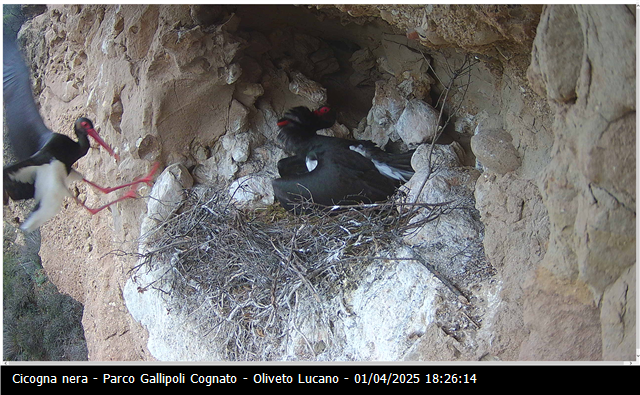you remember on this pic? now there is a short video about this event (link and text under this quote)
marika.solo wrote: ↑02 Apr 2025, 01:05here is the strange (great defending posture)

now (posted on 02.04.2025 at 13.14) there is short VIDEO about this event
https://www.facebook.com/gallipolicogna ... &ref=notif
LUI, LEI L’ALTRA!
Nel nido di Oliveto Lucano nel #parcogallipolicognato, la coppia di #cicognanera sembra non trovare un po’di intimità! Più di un mese fa, ha scelto questo nido per la riproduzione, ma è continuamente disturbata da un’altra coppia.
Nelle prime settimane di occupazione del nido, capita spesso di osservare degli intrusi che cercano di usurpare il sito. Per difendere il proprio nido, le cicogne eseguono un tipico display (modello motorio stereotipato) di minaccia, l’Up-Down with Bill Clattering, caratterizzato da movimenti veloci e ripetuti del collo verso il basso e poi verso l’alto e indietro, emettendo un suono meccanico prodotto dalla chiusura rapida del becco sbattendo le mandibole, e spesso con qualche beccata sul materiale del nido. Quando si verifica il tentativo di un intruso di posarsi sul nido, la cicogna esegue il Nest Covering Display in cui copre il nido.
HE, SHE THE OTHER!
In the nest of Oliveto Lucano in the parcogallipolicognato, the pair of ciconianigra seems to be unable to find a bit of privacy! More than a month ago, they chose this nest for breeding, but are continually disturbed by another pair.
In the first weeks of occupation of the nest, it often happens that intruders try to usurp the site. To defend their nest, storks perform a
typical threat display (stereotyped motor pattern), the Up-Down with Bill Clattering, characterised by fast and repeated movements of the neck downwards and then upwards and backwards, emitting a mechanical sound produced by the rapid closure of the bill by banging the mandibles, and often with some pecks on the nest material. When an intruder attempts to land on the nest, the stork performs the Nest Covering Display in which it covers the nest.










